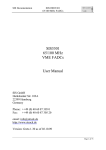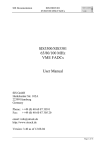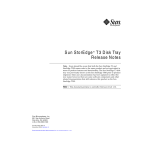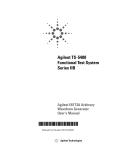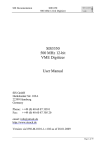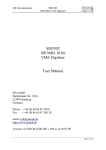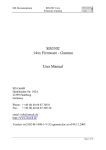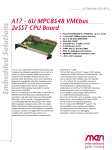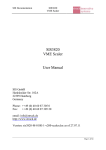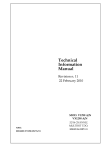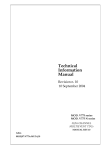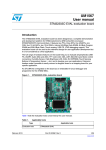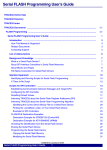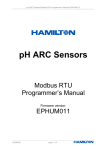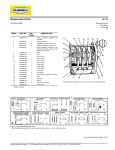Download SIS3300/SIS3301 65/100 MHz VME FADCs User Manual
Transcript
SIS Documentation SIS3300/3301 65/100 MHz FADCs SIS3300/SIS3301 65/100 MHz VME FADCs User Manual SIS GmbH Harksheider Str. 102A 22399 Hamburg Germany Phone: ++49 (0) 40 60 87 305 0 Fax: ++49 (0) 40 60 87 305 20 email: [email protected] http://www.struck.de Version: 3.00 as of 27.05.02 Page 1 of 64 SIS Documentation SIS3300/SIS3301 65/100 MHz FADC Revision Table: Revision 0.01 1.00 1.01 1.02 1.03 1.10 Date 27.09.00 15.01.01 17.01.01 21.01.01 01.06.01 01.08.01 2.00 2.10 2.11 3.0x 29.10.01 05.11.01 15.11.01 24.05.02 3.00 27.05.02 Page 2 of 64 Modification Generation First official release Trigger functionality added MBLT64 readout Bug fix in acquisition register Documentation: J190 description Design Version 2 : (added Multiplexer Mode) - Firmware Revision Register : 0x33000102 - new bit in Acquisition control register (bit 15; MULTIPLEXER Mode) - new Clock Predivider registers - new No_of_Sample registers - new Output 1 function in MULTIPLEXER Mode V2 hardware revision, extended functionality extended trigger functionality description Bug fixes, ADC chip frequency range Prerelease for major functionality/firmware upgrade V3 - implementation of gate chaining mode - introduction of averaging - 2e VME readout implementation - change in trigger bit behaviour Combination of SIS3300 and SIS3301 manual to one document Official release SIS Documentation SIS3300/3301 65/100 MHz FADCs - Table of contents 1 Table of contents ................................................................................................................. 3 Introduction ......................................................................................................................... 5 1.1 2 Related documents...................................................................................................................................5 Technical Properties/Features ............................................................................................. 6 2.1 Key functionality .....................................................................................................................................6 2.2 Module design .........................................................................................................................................7 2.2.1 Dual channel group..........................................................................................................................8 2.3 Modes of Operation .................................................................................................................................8 2.4 Memory management ..............................................................................................................................8 2.4.1 Single Event Mode...........................................................................................................................8 2.4.2 Multi Event Mode............................................................................................................................8 2.4.3 Dual Bank Mode..............................................................................................................................8 2.5 Clock sources...........................................................................................................................................9 2.5.1 Internal clock ...................................................................................................................................9 2.5.2 External clock ..................................................................................................................................9 2.5.3 Random External Clock...................................................................................................................9 2.6 Averaging ..............................................................................................................................................10 2.7 Trigger control (pre/post, start/stop and gate mode) ..............................................................................10 2.8 Internal Trigger generation ....................................................................................................................10 2.9 Time Stamp Memory .............................................................................................................................10 2.10 VME Interrupts......................................................................................................................................10 2.11 VME Readout Speed .............................................................................................................................11 3 VME Addressing............................................................................................................... 12 3.1 4 Address Map..........................................................................................................................................13 Register Description.......................................................................................................... 16 4.1 Control/Status Register(0x, write/read) .................................................................................................16 4.1.1 Trigger activation...........................................................................................................................17 4.1.2 Trigger routing...............................................................................................................................17 4.2 Module Id. and Firmware Revision Register (0x4, read).......................................................................18 4.2.1 Major revision numbers .................................................................................................................18 4.3 Interrupt configuration register (0x8) ....................................................................................................19 4.3.1 IRQ mode.......................................................................................................................................19 4.4 Interrupt control register (0xC)..............................................................................................................20 4.5 Acquisition control register (0x10, read/write)......................................................................................22 4.6 Start Delay register (0x14, read/write)...................................................................................................24 4.7 Stop Delay register (0x18, read/write)...................................................................................................24 4.8 Time stamp predivider register (0x1C)..................................................................................................25 4.9 Key address general reset (0x20, write).................................................................................................26 4.10 Key address VME start sampling (0x30, write).....................................................................................26 4.11 Key address VME stop sampling (0x34, write) .....................................................................................26 4.12 Key address start Auto Bank Switch mode (0x40, write) ......................................................................27 4.13 Key address stop Auto Bank Switch mode (0x44, write) ......................................................................27 4.14 Key address clear BANK1 FULL Flag (0x48, write) ...........................................................................27 4.15 Key address clear BANK2 FULL Flag (0x4C, write) ...........................................................................27 4.16 Event Time Stamp directory bank 1 (0x1000-0x1ffc, read only) ..........................................................28 4.17 Event Time Stamp directory bank 2 (0x2000-0x2ffc, read only) ..........................................................28 4.18 Event configuration registers (0x100000, 0x200000, 0x280000, 0x300000, 0x380000) .....................29 4.18.1 Gate chaining mode .......................................................................................................................30 4.18.2 Averaging mode.............................................................................................................................30 4.18.3 MULTIPLEXER MODE ...............................................................................................................30 4.18.4 EXTERNAL RANDOM CLOCK MODE ....................................................................................31 4.18.5 Page size ........................................................................................................................................31 4.19 Threshold registers (0x100004, 0x200004, 0x280004, 0x300004, 0x380004)......................................32 4.20 Trigger Flag Clear Counter register (0x10001C, 0x20001C, 0x28001C, 0x3001C, 0x38001C)..........34 4.21 Clock Predivider register (0x100020, 0x200020, 0x280020, 0x300020, 0x380020) ............................35 4.22 No_Of_Sample register (0x100024, 0x200024, 0x280024, 0x300024, 0x380024) ..............................36 Page 3 of 64 SIS Documentation SIS3300/SIS3301 65/100 MHz FADC 4.23 Trigger setup register registers (0x100028, 0x200028, 0x280028, 0x300028, 0x380028)....................37 4.24 MAX No of Events registers (0x10002C, 0x20002C, 0x28002C, 0x30002C, 0x38002C) ...................38 4.25 Trigger event directory bank 1 (0x101000 – 0x101ffc).........................................................................39 4.26 Trigger event directory bank 2 (0x102000 – 0x102ffc).........................................................................39 4.27 Event directories bank 1 ( 0x201000 – 0x201ffc, 0x281000 – 0x281ffc, 0x301000 – 0x301ffc, 0x381000 – 0x381ffc)........................................................................................................................................40 4.28 Event directories bank 2 ( 0x202000 – 0x202ffc, 0x282000 – 0x282ffc, 0x302000 – 0x302ffc, 0x382000 – 0x382ffc)........................................................................................................................................40 4.29 Bank 1 address counter (0x200008, 0x280008, 0x300008, 0x380008).................................................41 4.30 Bank 2 address counter (0x20000C, 0x28000C, 0x30000C, 0x38000C) ..............................................41 4.31 Bank 1 event counter (0x200010, 0x280010, 0x300010, 0x380010) ....................................................42 4.32 Bank 2 event counter (0x200014, 0x280014, 0x300014, 0x380014) ....................................................42 4.33 Actual Sample registers (0x200018, 0x280018, 0x300018, 0x380018) ................................................43 4.34 Bank 1 memory (0x400000 – 0x5ffffc) ................................................................................................44 4.35 Bank 2 memory (0x600000 – 0x7ffffc) ................................................................................................44 5 Description of Start/Stop and Gate operation modi .......................................................... 45 5.1 Start/stop mode ......................................................................................................................................45 5.1.1 Front panel start/stop .....................................................................................................................45 5.2 Gate mode..............................................................................................................................................45 5.3 Start logic summary ...............................................................................................................................46 5.4 Stop logic summary ...............................................................................................................................47 6 Operation........................................................................................................................... 48 6.1 6.2 6.3 6.4 6.5 7 8 Configuration:........................................................................................................................................48 Arm for sampling:..................................................................................................................................48 Start Sampling: ......................................................................................................................................48 Stop Sampling (Event):..........................................................................................................................49 End of Sampling (clear arm / disable Sample Clock): ...........................................................................49 Board layout ...................................................................................................................... 50 Front panel......................................................................................................................... 51 8.1 Control In/Outputs .................................................................................................................................52 8.1.1 User input.......................................................................................................................................52 8.1.2 Control input termination...............................................................................................................52 8.2 Analog inputs.........................................................................................................................................52 8.2.1 Single ended LEMO version..........................................................................................................52 8.2.2 Differential version ........................................................................................................................52 8.3 LED's .....................................................................................................................................................53 8.4 PCB LEDs .............................................................................................................................................53 9 Jumpers/Configuration ...................................................................................................... 54 9.1 J1............................................................................................................................................................54 9.1.1 SIS3300_V1...................................................................................................................................54 9.1.2 SIS3300_V2 (and higher) ..............................................................................................................54 9.2 J190 Reset..............................................................................................................................................54 9.3 Offset adjustment...................................................................................................................................55 9.4 JTAG .....................................................................................................................................................56 10 Appendix........................................................................................................................ 57 10.1 Data acquisition modes..........................................................................................................................57 10.1.1 Multiplexer mode...........................................................................................................................57 10.1.2 Random external clock mode.........................................................................................................58 10.1.3 Auto bank switch mode .................................................................................................................58 10.2 consumption...........................................................................................................................................59 10.3 Operating conditions..............................................................................................................................59 10.3.1 Cooling ..........................................................................................................................................59 10.3.2 Hot swap/live insertion ..................................................................................................................59 10.4 Connector types .....................................................................................................................................60 10.5 P2 row A/C pin assignments..................................................................................................................60 10.6 Row d and z Pin Assignments ...............................................................................................................61 11 Index .............................................................................................................................. 62 Page 4 of 64 SIS Documentation 1 SIS3300/3301 65/100 MHz FADCs Introduction The SIS3300/3301 are eight channel ADC/digitizer boards with a sampling rate of up to 105 MHz (for the individual channel) and a resolution of 12/14-bit. The boards are single width 6U VME card, which has no special (i.e. non standard VME) voltage requirements. Dual memory bank functionality in conjunction with multi event memory structure and a range of trigger options give the unit the flexibility to cover a variety of applications. Applications comprise but are not limited to: • digitization of “slow” detectors like calorimeters • spectroscopy with Ge-detecors • beam profile monitor readout • serialized readout of µ-Strip detector data As we are aware, that no manual is perfect, we appreciate your feedback and will try to incorporate proposed changes and corrections as quickly as possible. The most recent version of this manual can be obtained by email from [email protected], the revision dates are online under http://www.struck.de/manuals.htm. 1.1 Related documents A list of available firmware designs can be retrieved from http://www.struck.de/sis3300firm.htm The JTAG firmware installation procedure is described in http://www.struck.de/sis3300_jtagprog.pdf Page 5 of 64 SIS Documentation SIS3300/SIS3301 65/100 MHz FADC 2 Technical Properties/Features 2.1 Key functionality Find below a list of key features of the SIS3300 and SIS3301 digitizers. Sampling rate per channel Minimum symmetric clock Resolution Analog bandwidth Typical pedestal variance Differential input version 2 x 128 KSample default 2 x 512 KSample option (1) (2) SIS3300 105 MHz 1 MHz 12-bit > 80 MHz 0.7 bit X - SIS3301-65 65 MHz 15 MHz 14-bit 35 MHz (1) 1.1 bit (2) X X X SIS3301-105 105 MHz 15 MHz 14-bit X X X limited for better resolution with symmetric input range Common properties of all boards are: • • • • • • • • • • • • • • • • • • • • 8 channels special clock modes (clock prescaling, external “arbitrary” clock) channel to channel crosstalk below noise (i.e. invisible in Fourier spectrum) external/internal clock multi event mode N sample averaging (N= 2,4, 8, ..., 128) Read on the fly (actual sample value) pre/post trigger option Two independent memory banks trigger generation 4 NIM control inputs/4 NIM control outputs A32 D32/BLT32/MBLT64/2eVME Geographical addressing mode (in conjunction with VME64x backplane) Hot swap (in conjunction with VME64x backplane) VME64x Connectors VME64x Side Shielding VME64x Front panel VME64x extractor handles (on request) F1002 compatible P2 row A/C assignment +5 V, +12V and –12 V VME standard voltages Note: The SIS3300/1 shall not be operated on P2 row A/C extensions, like VSB e.g. due to the compatibility to the F1001 FADC modules clock and start/stop distribution scheme. Page 6 of 64 SIS Documentation SIS3300/3301 65/100 MHz FADCs 2.2 Module design The SIS3300 consists of four identical groups of 2 ADC channels and a control section as shown in the simplified block diagram below. Front Panel Control I/O VME Interface and Control FPGA VMEBus System Clock Clock Distribution Dual Channel Group 4 (Channels 7 and 8) Dual Channel Group 3 (Channels 5 and 6) Dual Channel Group 2 (Channels 3 and 4) Dual Channel Group 1 (Channels 1 and 2) Page 7 of 64 SIS Documentation SIS3300/SIS3301 65/100 MHz FADC 2.2.1 Dual channel group Two ADC channels form a group, which memory is handled by one Field Programmable Gate Array (FPGA). 32 12/14 Input Stage 2 Data ADC 2 Address FPGA Input Stage 1 ADC 1 17 32 12/14 Event Directory Memory Bank 2 Data Address Memory Bank 1 17 2.3 Modes of Operation The SIS3300 was developed with maximum flexibility in mind. The FPGA based design of the card allows to meet the requirements of many readout applications with dedicated firmware designs in the future. The initial firmware is supposed to furnish you with an easy to use yet powerful high speed high resolution Flash Analog to Digital Converter (FADC) implementation, that covers many everyday analog to digital applications. 2.4 Memory management The individual memory bank(s) can be used either as one contiguous memory or as a subdivided multi event memory. In addition memory depth can be limited in single event operation to match the requirements of the given application. The memory configuration is defined through the memory configuration register, while bank handling (on dual memory bank modules) is under control of the acquisition control register. 2.4.1 Single Event Mode The full memory of 128 K Samples of the SIS3300/1 is used as one big circular buffer or as single shot memory in single event mode, unless memory size is limited by the event configuration register. 2.4.2 Multi Event Mode The memory can be divided in up to 1024 pages or events to make the acquisition of shorter signals more efficient. The stop pointers for the individual page can be retrieved from the event directory. In auto start mode the ADC advances to the next page and starts sampling automatically. 2.4.3 Dual Bank Mode Dual bank mode (Bank Switch mode) is available on cards (except SIS3300 V1 PCBs). The single/multi event selection will influence both memory banks in the same fashion. Data from the inactive bank can be readout, while the other bank is acquiring new data. Page 8 of 64 SIS Documentation SIS3300/3301 65/100 MHz FADCs 2.5 Clock sources The SIS3300/3301 features 3 basic clock modes • Internal clock • External symmetric clock • External random clock 2.5.1 Internal clock The internal clock is generated from an on board 50 MHz quartz. It is either doubled by a delay locked loop to 100 MHz or divided down to lower clock frequencies. The table below lists the valid clock settings for the different SIS3300/3301 boards. Clock 100 MHz 50 MHz 25 MHz 12.5 MHz 6.25 MHz 3.125 MHz SIS3300 X X X X X X SIS3301-65 X X - SIS3301-105 X X X - 2.5.2 External clock A symmetric external clock (NIM level, ratio between 45:55 and 55:45) can be fed to the module through a LEMO00 connector. An ECL clock over rows A/C of the J2 VME backplane can be used as an alternative. For optimum performance the clock frequency should be within the specified range for the given ADC chip. Module SIS3300 SIS3301-65 SIS3301-105 Min. sym. clock 1 MHz 15 MHz 15 MHz Max sym. clock 105 MHz 65 MHz 105 MHz 2.5.3 Random External Clock Random external clock mode allows to operate the SIS3300/1 with basically arbitrary external clock pulse trains or slow external clocks. The module is clocked with the internal clock (typically at 100 MHz) and a data word will be stored to memory upon the next leading edge of the internal clock after a leading edge on the external clock input is detected. Internal pipelining has to be taken into account, the datum will precede the clock by 10 clock ticks (i.e. about 100 ns on a SIS3300 clocking at 100 MHz). Page 9 of 64 SIS Documentation SIS3300/SIS3301 65/100 MHz FADC 2.6 Averaging Averaging over N (N=2, 4, 8, ..., 128) consecutive samples can be used to cover the domain of lower speed digitizers with the SIS3300/1 cards without compromising on the resolution/signal to noise ratio side. 2.7 Trigger control (pre/post, start/stop and gate mode) The SIS3300/1 features pre/post trigger capability as well as start/stop mode acquisition and a gate mode (in which start and stop are derived from the leading and trailing edge of a single control input signal). The trigger behaviour is defined by the acquisition control register. 2.8 Internal Trigger generation The trigger output of the SIS3300/1 can be either used to interact with external trigger logic or to base start/stop on a threshold (i.e. one individual threshold per ADC channel) of the digitized data. Trigger generation can be activated with two conditions: • module armed (i.e. sample clock active, trigger can be used to start acquisition) • module armed and started (trigger can be used to stop acquisition) The user can select between triggering on the conditions above and below threshold 2.9 Time Stamp Memory A 1024 x 24 bit Time Stamp Memory is implemented for each memory bank. An internal counter starts with the first Stop trigger condition in multievent mode and it will be incremented with the sample clock or with the predivided sample clock (factor 1 to 256). Each stop trigger condition (end of event) writes the counter value into Time Stamp Memory. 2.10 VME Interrupts Two registers, the Interrupt configuration and the Interrupt control register, are implemented for interrupt setup and control. Four Interrupt sources are implemented: - External User Input (LEMO input 1) - End of event - End of last event in multievent mode - Memory bank full in bank switch mode (Dual bank) Page 10 of 64 SIS Documentation SIS3300/3301 65/100 MHz FADCs 2.11 VME Readout Speed The VME interface is optimized for readout speed. An internal FIFO/pipeline structure allows for high speed readout in block transfer mode (BLT32, MBLT64, 2eVME). The timings below were measured with the SIS3100 (VME master) and the SIS3300/SIS3301 (VME Slave). The upper scope trace shows the VME signal DS1* (Data strobe, low active). The VME Master asserts the DS1* to request (read) data. The lower signal shows the VME signal DTACK* (Data Acknowledge, low active). The VME Slave asserts the DTACK* to acknowledge. that the data is valid on VME. SIS330x DS* to DTACK* : 30-40ns 32bit every 120ns -- > ~ 33 MByte/sec BLT32 SIS330x DS* to DTACK* : 30-40ns 64bit every 125ns -- > ~ 64 MByte/sec MBLT64 SIS330x DS* to DTACK* : 50-60ns 128bit every 200ns --> ~ 80 MByte/sec 2eVME Page 11 of 64 SIS Documentation SIS3300/SIS3301 65/100 MHz FADC 3 VME Addressing As the SIS3300 VME FADC features memory options with up to 2 banks of 4 times 128 K samples each, A32 addressing was implemented as the only option. Hence the module occupies an address space of 0xFFFFFF Bytes (i.e. 16 MBytes) are used by the module. The SIS3300/1 firmware addressing concept is a pragmatic approach to combine standard rotary switch style settings with the use of VME64x backplane geographical addressing functionality. The base address is defined by the selected addressing mode, which is defined by jumper array J1 and possibly SW1 and SW2 (in non geographical mode). J1 Function EN_A32 EN_GEO EN_VIPA reserved The table below summarises the possible base address settings. x Shorthand SW1/SW2 GA0-GA4 GA0 GA1 GA2 GA3 GA4 0 x 0 x 0 J1 Setting Bits A32 GEO VIPA 31 30 29 28 27 26 25 24 x SW1 SW2 Not implemented in this design Explanation Setting of rotary switch SW1 or SW2 respective Geographical address bit as defined by the VME64x(P) backplane Notes: • This concept allows the use of the SIS3300/1 in standard VME as well as in VME64x environments, i.e. the user does not need to use a VME64x backplane. • The factory default setting is EN_A32 closed, SW1=3, SW2=0 (i.e. the module will react to A32 addressing under address 0x30000000) • Early SIS3300 boards (PCB SIS3300_V1) have a different base address scheme Page 12 of 64 SIS Documentation SIS3300/3301 65/100 MHz FADCs 3.1 Address Map The SIS3300 resources and their locations are listed in the table below. Note: Write access to a key address (KA)with arbitrary data invokes the respective action Offset Size in Bytes BLT Access - W/R R R/W R/W R/W BLT32 BLT32 R/W R/W R/W KA W KA W KA W KA W KA W KA W KA W R R Control/Status Register (J-K register) Module Id. and Firmware Revision register Interrupt configuration register Interrupt control register Acquisition control/status register (J-K register) Extern Start Delay register Extern Stop Delay register Time stamp predivider register General Reset VME Start sampling VME Stop sampling Start auto bank switch Stop auto bank switch Clear bank 1 memory full Clear bank 2 memory full Event Time Stamp directory bank 1 Event Time Stamp directory bank 2 Event information all ADC groups 0x00100000 4 0x00100004 4 0x0010001C 4 0x00100020 4 0x00100024 4 0x00100028 4 0x0010002C 4 0x00101000 0x1000 BLT32 0x00102000 0x1000 BLT32 W only W only W only W only W only W only W only R R Event configuration register (all ADCs) Trigger Threshold register (all ADCs) Trigger Flag Clear Counter register (all ADCs) Clock Predivider register (all ADCs) No_Of_Sample register (all ADCs) Trigger setup register (all ADCs) Max. No of Events register (all ADCs) Event directory bank 1 (all ADCs) Eevent directory bank 2 (all ADCs) 0x00000000 0x00000004 0x00000008 0x0000000C 0x00000010 4 4 4 4 4 0x00000014 0x00000018 0x0000001C 0x00000020 0x00000030 0x00000034 0x00000040 0x00000044 0x00000048 0x0000004C 0x00001000 0x00002000 4 4 4 4 4 4 4 4 4 4 0x1000 0x1000 Event information ADC group 1 0x00200000 4 0x00200004 4 0x00200008 4 0x0020000C 4 0x00200010 4 0x00200014 4 0x00200018 4 0x0020001C 4 0x00200020 0x00200024 0x00200028 0x0020002C 0x00201000 0x00202000 4 4 4 4 0x1000 0x1000 Event information ADC group 2 0x00280000 4 - R/W R/W R R R R R R/W BLT32 BLT32 R/W R/W R/W R/W R R - R/W Function Event configuration register (ADC1, ADC2) Trigger Threshold register (ADC1, ADC2) Bank1 address counter (ADC1, ADC2) Bank2 address counter (ADC1, ADC2) Bank1 Event counter (ADC1, ADC2) Bank2 Event counter (ADC1, ADC2) Actual Sample Value (ADC1, ADC2) Trigger Flag Clear Counter register (ADC1, ADC2) Clock Predivider register (ADC1, ADC2) No_Of_Sample register (ADC1, ADC2) Trigger setup register (ADC1, ADC2) Max. No of Events register (ADC1, ADC2) Event directory bank 1 (ADC1, ADC2) Event directory bank 2 (ADC1, ADC2) Event configuration register (ADC3, ADC4) Page 13 of 64 SIS Documentation SIS3300/SIS3301 65/100 MHz FADC 0x00280004 0x00280008 0x0028000C 0x00280010 0x00280014 0x00280018 0x0028001C 4 4 4 4 4 4 4 0x00280020 0x00280024 0x00280028 0x0028002C 0x00281000 0x00282000 4 4 4 4 0x1000 0x1000 Event information ADC group 3 0x00300000 4 0x00300004 4 0x00300008 4 0x0030000C 4 0x00300010 4 0x00300014 4 0x00300018 4 0x0030001C 4 0x00300020 0x00300024 0x00300028 0x0030002C 0x00301000 0x00302000 4 4 4 4 0x1000 0x1000 Event information ADC group 4 0x00380000 4 0x00380004 4 0x00380008 4 0x0038000C 4 0x00380010 4 0x00380014 4 0x00380018 4 0x0038001C 4 0x00380020 0x00380024 0x00380028 0x0038002C 0x00381000 0x00382000 Bank 1 memory 0x00400000 0x00480000 0x00500000 0x00580000 Bank 2 memory Page 14 of 64 4 4 4 4 0x1000 0x1000 0x80000 0x80000 0x80000 0x80000 - BLT32 BLT32 - BLT32 BLT32 - BLT32 BLT32 R/W R R R R R R/W R/W R/W R/W R/W R R R/W R/W R R R R R R/W R/W R/W R/W R/W R R R/W R/W R R R R R R/W R/W R/W R/W R/W R R Trigger Threshold register (ADC3, ADC4) Bank1 address counter (ADC3, ADC4) Bank2 address counter (ADC3, ADC4) Bank1 Event counter (ADC3, ADC4) Bank2 Event counter (ADC3, ADC4) Actual Sample Value (ADC1, ADC2) Trigger Flag Clear Counter register (ADC1, ADC2) Clock Predivider register (ADC3, ADC4) No_Of_Sample register (ADC3, ADC4) Trigger setup register (ADC3, ADC4) Max. No of Events register (ADC3, ADC4) Event directory bank 1 (ADC3, ADC4) Event directory bank 2 (ADC3, ADC4) Event configuration register (ADC5, ADC6) Trigger Threshold register (ADC5, ADC6) Bank1 address counter (ADC5, ADC6) Bank2 address counter (ADC5, ADC6) Bank1 Event counter (ADC5, ADC6) Bank2 Event counter (ADC5, ADC6) Actual Sample Value (ADC1, ADC2) Trigger Flag Clear Counter register (ADC1, ADC2) Clock Predivider register (ADC5, ADC6) No_Of_Sample register (ADC5, ADC6) Trigger setup register (ADC5, ADC6) Max. No of Events register (ADC5, ADC6) Event directory bank 1 (ADC5, ADC6) Event directory bank 2 (ADC5, ADC6) Event configuration Register (ADC7, ADC8) Trigger Threshold register (ADC7, ADC8) Bank1 address counter (ADC7, ADC8) Bank2 address counter (ADC7, ADC8) Bank1 Event counter (ADC7, ADC8) Bank2 Event counter (ADC7, ADC8) Actual Sample Value (ADC7, ADC8) Trigger Flag Clear Counter register (ADC1, ADC2) Clock Predivider register (ADC7, ADC8) No_Of_Sample register (ADC7, ADC8) Trigger setup register (ADC7, ADC8) Max. No of Events register (ADC7, ADC8) Event directory bank 1 (ADC7, ADC8) Event directory bank 2 (ADC7, ADC8) BLT32/MBLT64/2eVME BLT32/MBLT64/2eVME BLT32/MBLT64/2eVME BLT32/MBLT64/2eVME R/W* R/W* R/W* R/W* Bank 1 memory (ADC1, ADC2) Bank 1 memory (ADC3, ADC4) Bank 1 memory (ADC5, ADC6) Bank 1 memory (ADC7, ADC8) SIS Documentation 0x00600000 0x00680000 0x00700000 0x00780000 0x80000 0x80000 0x80000 0x80000 SIS3300/3301 65/100 MHz FADCs BLT32/MBLT64/2eVME BLT32/MBLT64/2eVME BLT32/MBLT64/2eVME BLT32/MBLT64/2eVME R/W* R/W* R/W* R/W* Bank 2 memory (ADC1, ADC2) Bank 2 memory (ADC3, ADC4) Bank 2 memory (ADC5, ADC6) Bank 2 memory (ADC7, ADC8) * W in D32 only (for memory test e.g.) Note 1: The event information is identical for the four ADC groups (unless the module has a hardware problem), hence it will be sufficient for normal operation to retrieve the needed information from one group only. Note 2: MBLT64 and 2eVME read access is supported from the memory banks only. Page 15 of 64 SIS Documentation SIS3300/SIS3301 65/100 MHz FADC 4 Register Description The function of the individual registers is described in detail in this section. The first line after the subsection header (in Courier font) like: #define SIS3300_CONTROL_STATUS 0x0 /* read/write; D32 */ refers to the sis3300.h header file. 4.1 Control/Status Register(0x, write/read) #define SIS3300_CONTROL_STATUS 0x0 /* read/write; D32 */ The control register is in charge of the control of basic properties of the SIS3300/1 board, like output signal assignment, in write access. It is implemented via a selective J/K register, a specific function is enabled by writing a 1 into the set/enable bit, the function is disabled by writing a 1 into the clear/disable bit (which location is 16-bit higher in the register). An undefined toggle status will result from setting both the enable and disable bits for a specific function at the same time. On read access the same register represents the status register. Bit 31 30 29 28 27 26 25 24 23 22 21 20 19 18 17 16 15 14 13 12 11 10 9 8 write Function Clear reserved 15 (*) Clear reserved 14 (*) Clear reserved 13 (*) Clear reserved 12 (*) Clear reserved 11 (*) clear bank full pulse to output 3 (*) clear bank full pulse to output 2 (*) clear bank full pulse to output 1 (*) Clear reserved 7 (*) Disable internal trigger routing (*) Activate trigger upon armed (*) Non inverted trigger output (*) Clear reserved 3 (*) Enable user output/disable trigger output (*) Clear user output (*) Switch off user LED (*) Set reserved 15 Set reserved 14 Set reserved 13 Set reserved 12 Set reserved 11 set bank full pulse to output 3 set bank full pulse to output 2 set bank full pulse to output 1 7 6 Set reserved 7 Enable internal trigger routing 5 Activate trigger upon armed and started 4 Invert trigger output 3 Set reserved 3 Page 16 of 64 read Function Status P2_SAMPLE_IN Status P2_RESET_IN Status P2_TEST_IN Status User Input Status Control 15 Status Control 14 Status Control 13 Status Control 12 Status Control 11 Status Bank full pulse on LEMO output 3 Status Bank full pulse on LEMO output 2 Status Bank full pulse on LEMO output 1 (highest priority) Status Control 7 Status trigger routing (1= to input, 0=don’t route) Status trigger generation (1=armed and started, 0=armed) Status trigger output inversion(1=inverted, 0=straight) Status Control 3 SIS Documentation SIS3300/3301 65/100 MHz FADCs 2 Enable trigger output/disable user output 1 Set user output (if bit 2 is not set) 0 Switch on user LED multiplexer mode = 0: Status of user/trigger output (1=trigger output, 0=user output) multiplexer mode = 1: output set by multiplexer out pulse Status User Output (1=output on, 0=output off) Status User LED (1=LED on, 0=LED off) (*) denotes power up default setting 4.1.1 Trigger activation Trigger generation can be activated for two states of the SIS3300/1. By default trigger generation is active as soon as the module is armed (i.e. a sample clock is active). In this mode the trigger can be used to start the digitizer (with stop condition end of event e.g.). Trigger generation upon armed and started (i.e. bit 6 of the control register set), the trigger is used to stop the module (what is a efficient mode of operation in conjunction with autostart e.g.). 4.1.2 Trigger routing The trigger status is present on LEMO output 1 (with user output and multiplexer mode disabled). It can be used to form a general trigger decision with external trigger electronics, which is fed back to the corresponding input (start/stop) on the digitizer(s). The trigger is routed on board to the stop input with the internal trigger routing bit set. Page 17 of 64 SIS Documentation 4.2 SIS3300/SIS3301 65/100 MHz FADC Module Id. and Firmware Revision Register (0x4, read) #define SIS3300_MODID 0x4 /* read only; D32 */ This register reflects the module identification of the SIS3300/1 and its minor and major firmware revision levels. The major revision level will be used to distinguish between substantial design differences and experiment specific designs, while the minor revision level will be used to mark user specific adaptations. Bit 31 30 29 28 27 26 25 24 23 22 21 20 19 18 17 16 15 14 13 12 11 10 9 8 7 6 5 4 3 2 1 0 Function Module Id. Bit 15 Module Id. Bit 14 Module Id. Bit 13 Module Id. Bit 12 Module Id. Bit 11 Module Id. Bit 10 Module Id. Bit 9 Module Id. Bit 8 Module Id. Bit 7 Module Id. Bit 6 Module Id. Bit 5 Module Id. Bit 4 Module Id. Bit 3 Module Id. Bit 2 Module Id. Bit 1 Module Id. Bit 0 Major Revision Bit 7 Major Revision Bit 6 Major Revision Bit 5 Major Revision Bit 4 Major Revision Bit 3 Major Revision Bit 2 Major Revision Bit 1 Major Revision Bit 0 Minor Revision Bit 7 Minor Revision Bit 6 Minor Revision Bit 5 Minor Revision Bit 4 Minor Revision Bit 3 Minor Revision Bit 2 Minor Revision Bit 1 Minor Revision Bit 0 Reading 4.2.1 Major revision numbers Find below a table with major revision numbers used to date Major revision number 0x01 to 0x0F 0x10 Page 18 of 64 Application/user Generic designs Amanda 3 3 0 0/1 SIS Documentation 4.3 SIS3300/3301 65/100 MHz FADCs Interrupt configuration register (0x8) #define SIS3300_IRQ_CONFIG 0x8 /* read/write; D32 */ This read/write register controls the VME interrupt behaviour of the SIS3300 ADC. Four interrupt sources are foreseen, for the time being three of them are associated with an interrupt condition, the fourth condition is reserved for future use. The interrupter type is DO8 . 4.3.1 IRQ mode In RORA (release on register access) mode the interrupt will be pending until the IRQ source is cleared by specific access to the corresponding disable VME IRQ source bit. After the interrupt is serviced the source has to be activated with the enable VME IRQ source bit again. In ROAK (release on acknowledge) mode , the interrupt condition will be cleared (and the IRQ source disabled) as soon as the interrupt is acknowledged by the CPU. After the interrupt is serviced the source has to be activated with the enable VME IRQ source bit again. ROAK IRQ mode can be used in conjunction with the University of Bonn LINUX Tundra Universe II driver by Dr. Jürgen Hannappel on Intel based VME SBCs. Bit 31 ... 16 15 14 13 12 11 10 9 8 7 6 5 4 3 2 1 0 Function RORA/ROAK Mode (0: RORA; 1: ROAK) VME IRQ Enable (0=IRQ disabled, 1=IRQ enabled) VME IRQ Level Bit 2 VME IRQ Level Bit 1 VME IRQ Level Bit 0 IRQ Vector Bit 7; placed on D7 during VME IRQ ACK cycle IRQ Vector Bit 6; placed on D6 during VME IRQ ACK cycle IRQ Vector Bit 5; placed on D5 during VME IRQ ACK cycle IRQ Vector Bit 4; placed on D4 during VME IRQ ACK cycle IRQ Vector Bit 3; placed on D3 during VME IRQ ACK cycle IRQ Vector Bit 2; placed on D2 during VME IRQ ACK cycle IRQ Vector Bit 1; placed on D1 during VME IRQ ACK cycle IRQ Vector Bit 0; placed on D0 during VME IRQ ACK cycle Default 0 0 0 0 0 0 0 0 0 0 0 0 0 0 0 0 0 0 0 The power up default value reads 0x 00000000 Page 19 of 64 SIS Documentation 4.4 SIS3300/SIS3301 65/100 MHz FADC Interrupt control register (0xC) #define SIS3300_IRQ_CONTROL 0xC /* read/write; D32 */ This register controls the VME interrupt behaviour of the SIS3300 ADC. Four interrupt sources are foreseen, for the time being three of them are associated with an interrupt condition, the fourth condition is reserved for future use. Bit 31 30 29 28 27 26 25 24 23 22 21 20 19 18 17 16 15 14 13 12 11 ... 4 3 2 1 0 Function (w) unused unused unused unused unused unused unused unused Clear IRQ source 3 Clear IRQ source 2 Clear IRQ source 1 Clear IRQ source 0 Disable IRQ source 3 Disable IRQ source 2 Disable IRQ source 1 Disable IRQ source 0 unused unused unused unused unused ... unused Enable IRQ source 3 Enable IRQ source 2 Enable IRQ source 1 Enable IRQ source 0 (r) Status IRQ source 3 (user input) Status IRQ source 2 (reserved) Status IRQ source 1 (end of last event, bank full) Status IRQ source 0 (end of event) Status VME IRQ Status internal IRQ 0 0 Status flag source 3 Status flag source 2 Status flag source 1 Status flag source 0 0 0 0 0 0 0 0 0 0 ... 0 Status enable source 3 (read as 1 if enabled, 0 if disabled) Status enable source 2 (read as 1 if enabled, 0 if disabled) Status enable source 1 (read as 1 if enabled, 0 if disabled) Status enable source 0 (read as 1 if enabled, 0 if disabled) The power up default value reads 0x 00000000 Page 20 of 64 Default 0 0 0 0 0 0 0 0 0 0 0 0 0 0 0 0 0 0 0 0 0 0 0 0 0 0 0 SIS Documentation SIS3300/3301 65/100 MHz FADCs The generation of the status flags, the IRQ flags and the actual IRQ is illustrated with the schematic below: Status FLAG Source 0 Source 0 Clear Source 1 Source 2 Clear AND Status IRQ Source 1 Enable 1 Status FLAG Source 2 AND VME_IRQ internal VME_IRQ OR Clear Status IRQ Source 2 Enable 2 Status FLAG Source 3 Source 3 Clear Status IRQ Source 0 Enable 0 Status FLAG Source 1 Clear AND AND Status IRQ Source 3 Enable 3 VME_IRQ_ENABLE ROAK AND RD_IRQ_ACK Page 21 of 64 SIS Documentation 4.5 SIS3300/SIS3301 65/100 MHz FADC Acquisition control register (0x10, read/write) #define SIS3300_ACQUISTION_CONTROL 0x10 /* read/write; D32 */ The acquisition control register is in charge of most of the settings related to the actual configuration of the digitization process. Like the control register it is implemented in a J/K fashion. Bit 31 30 29 28 27 26 25 24 23 22 21 20 19 18 17 16 15 14 13 12 11 10 9 8 7 6 5 4 3 2 1 0 Write Function Clear multiplexer mode Clear Clock Source Bit2 Clear Clock Source Bit1 Clear Clock Source Bit0 Disable external clock random mode Disable front panel gate mode (not start/stop) Disable P2 Start/Stop logic Disable front panel LEMO start/stop logic Disable external stop delay Disable external start delay Disable multi event mode 0 : Enable sample clock will be cleared with end of event 1 : Enable sample clock will be cleared at end of bank only (i.e. with last page of memory) Disable Autostart (in multi event mode only ) Disable reserved Disable auto bank switch mode Disable sample clock for memory bank 2 (disarm sampling) Disable sample clock for memory bank 1 (disarm sampling) Set multiplexer mode Set clock source Bit 2 Set clock source Bit 1 Set clock source Bit 0 Enable external clock random mode Enable front panel gate mode (not Start/Stop) Enable P2 Start/Stop logic Enable front panel Lemo Start/Stop logic Enable stop delay (value defined by stop delay register) Enable start delay (value defined by start delay register) Enable multi event mode 0 : Enable Sample Clock will be cleared with end of event 1 : Enable Sample Clock will be cleared at end of bank only (i.e. with last page of memory) Enable Autostart (in multi event mode only ) Enable reserved Enable auto bank switch mode Enable Sample Clock for Memory Bank 2 (arm for sampling) Enable Sample Clock for Memory Bank 1 (arm for sampling) The power up default value reads 0x Page 22 of 64 Read 0 0 0 0 0 0 0 0 Bank 2 full Bank 2 busy Bank 1 full Bank 1 busy 0 Bank switch busy 0 ADC_BUSY Status multiplexer mode Status clock source Bit 2 Status clock source Bit 1 Status clock source Bit 0 Status external clock random mode Status front panel gate mode Status P2 start/stop logic Status front panel start/stop logic Status stop delay Status start delay Status multi event mode Status Autostart Status reserved Status auto bank switch mode Status sample clock bank 2 Status sample clock bank 1 SIS Documentation SIS3300/3301 65/100 MHz FADCs Clock source bit setting table: Clock Source Bit2 0 0 0 0 1 1 1 1 Clock Source Bit1 0 0 1 1 0 0 1 1 Clock Source Bit0 0 1 0 1 0 1 0 1 Clock Source internal 100 MHz internal 50 MHz internal 25 MHz internal 12.5 MHz internal 6.25 MHz internal 3.125 MHz external clock (front panel) P2-Clock Refer to the table in section 2.5.2for allowed clock speeds. Lower sampling rates into memory can be accomplished with a sampling clock within the specified range in combination with the clock predivider register in multiplexer mode or random external clock mode. Page 23 of 64 SIS Documentation 4.6 SIS3300/SIS3301 65/100 MHz FADC Start Delay register (0x14, read/write) #define SIS3300_START_DELAY 0x14 /* read/write; D32 */ Pretrigger operation can be implemented via the start delay register in conjunction with front panel start/stop or gate mode operation. The external and autostart start signal (or leading edge of the gate) will be delayed by the value of the register+2 clocks if the external start delay is enabled in the acquisition control register. Bit 32 ... 16 15 .. .. 0 unused, read as 0 unused, read as 0 START_DELAY_BIT15 START_DELAY_BIT0 The power up default value is 0 4.7 Stop Delay register (0x18, read/write) #define SIS3300_STOP_DELAY 0x18 /* read/write; D32 */ Posttrigger operation can be implemented via the stop delay register in conjunction with front panel start/stop or gate mode operation. The external stop signal (or trailing edge of the gate) will be delayed by the value of the register+2 clocks if the stop delay is enabled in the acquisition control register. Bit 32 ... 16 15 .. .. 0 unused, read as 0 unused, read as 0 STOP_DELAY_BIT15 STOP _DELAY_BIT0 The power up default value is 0 Page 24 of 64 SIS Documentation SIS3300/3301 65/100 MHz FADCs Note: The user can generate a gate of defined length (in clock ticks) by fanning a short pulse to the start and stop input with start/stop mode active, stop delay enabled and the stop delay register programmed to the desired gate width. Pipelining will have to be taken into account, i.e. the digitised signal is about 40 ns (with the module sampling at 100 MHz) ahead of the respective control signal, a fact that can be used in external trigger decisions. For longer external trigger decisions one can consider to pipeline the ADC data in the FPGA in future firmware revisions before storing them to memory. 4.8 Time stamp predivider register (0x1C) #define SIS3300_TIMESTAMP_PREDIVIDER 0x1C /* read/write; D32 */ The (read/write) time stamp predivider register is used to define a prescale factor for the frequency of the time stamp counter. The time stamp counter counts at the clock rate with the time stamp predivider value of 0 and 1, a prescale factor of 2 ... 65535 is selected by writing the corresponding value to the register. Bit 31 ... 16 15 .. .. 0 unused, read as 0 unused, read as 0 Time stamp predivider BIT15 Time stamp predivider BIT0 The power up default value is 0 Note: A predivider value of 0 can not be used with firmware V201 Page 25 of 64 SIS Documentation 4.9 SIS3300/SIS3301 65/100 MHz FADC Key address general reset (0x20, write) #define SIS3300_KEY_RESET 0x20 /* write only; D32 */ A write with arbitrary data to this register (key address) resets the SIS3300 to it’s power up state. 4.10 Key address VME start sampling (0x30, write) #define SIS3300_KEY_START 0x30 /* write only; D32 */ A write with arbitrary data to this register (key address) will initiate sampling on the active memory bank if a bank is armed for sampling. 4.11 Key address VME stop sampling (0x34, write) #define SIS3300_KEY_STOP 0x34 /* write only; D32 */ A write with arbitrary data to this register (key address) will halt sampling on the active page. In Single Event Mode or during the last page the sampling this command will halt the the sampling. To Abort a sampling in Multi Event / Multibank mode the following cycles have to be executed: - issue “disable autostart” / issue KEY_STOP_AUTO_BANK_SWITCH - issue SIS3300_KEY_STOP - issue clear BX_ENABLE Page 26 of 64 SIS Documentation SIS3300/3301 65/100 MHz FADCs 4.12 Key address start Auto Bank Switch mode (0x40, write) #define SIS3300_KEY_START_AUTO_BANK_SWITCH 0x40 /* write only; D32 */ A write with arbitrary data to this register (key address) will start the auto bank switch mode. 4.13 Key address stop Auto Bank Switch mode (0x44, write) #define SIS3300_KEY_STOP_AUTO_BANK_SWITCH 0x44 /* write only; D32 */ A write with arbitrary data to this register (key address) will stop the auto bank switch mode. 4.14 Key address clear BANK1 FULL Flag (0x48, write) #define SIS3300_KEY_BANK1_FULL_FLAG 0x48 /* write only; D32 */ A write with arbitrary data to this register (key address) will clear the BANK1 FULL Flag. 4.15 Key address clear BANK2 FULL Flag (0x4C, write) #define SIS3300_KEY_BANK2_FULL_FLAG 0x4C /* write only; D32 */ A write with arbitrary data to this register (key address) will clear the BANK2 FULL Flag. Page 27 of 64 SIS Documentation SIS3300/SIS3301 65/100 MHz FADC 4.16 Event Time Stamp directory bank 1 (0x1000-0x1ffc, read only) #define SIS3300_EVENT_TIMESTAMP_DIR_BANK1 0x1000 /* read only; D32, BLT32; size: 0x1000 */ The event time stamp directory can be used to measure time between triggers (stops) in multi event mode. A scaler counting the ADC clock is enabled with the first stop (hence the time stamp for the first event will read 0 always). The counter value (of the 24-bit wide) scaler is written to the corresponding location for subsequent events. offset address 0x0 .. 0xffc Time Stamp (D23:D0) Time Stamp 0 Time Stamp 1023 4.17 Event Time Stamp directory bank 2 (0x2000-0x2ffc, read only) #define SIS3300_EVENT_TIMESTAMP_DIR_BANK2 0x2000 /* read only; D32, BLT32; size: 0x1000 */ As for bank 1. offset address 0x0 .. 0xffc Page 28 of 64 Time Stamp (D23:D0) Time Stamp 0 Time Stamp 1023 SIS Documentation SIS3300/3301 65/100 MHz FADCs 4.18 Event configuration registers (0x100000, 0x200000, 0x280000, 0x300000, 0x380000) #define SIS3300_EVENT_CONFIG_ALL_ADC 0x100000 /* write only;D32 */ #define #define #define #define SIS3300_EVENT_CONFIG_ADC12 SIS3300_EVENT_CONFIG_ADC34 SIS3300_EVENT_CONFIG_ADC56 SIS3300_EVENT_CONFIG_ADC78 0x200000 0x280000 0x300000 0x380000 /* /* /* /* read/write;D32 read/write;D32 read/write;D32 read/write;D32 */ */ */ */ This register is implemented for each channel group and it has to be written with the same value, the best way is to make use of the address SIS3300_EVENT_CONFIG_ALL_ADC to write to the registers of all channel groups simultaneously. The number of memory divisions (events) is defined by this register in multi event mode. The lowest three bits define the number of memory divisions as listed in the table below. On dual bank units both memory banks will be affected by the configuration of the event configuration register. The maximum number of events is defined by the size of the event directory, which has 1024 entries. The maximum number of events is limited to 65535 in gate chaining mode to allow for shorter gates also. . Bit 31 ... 20 19 18 17 16 15 14 13 12 11 10 9 8 7 6 5 4 3 2 1 0 function unused; read 0 ... unused; read 0 Event_CONF Bit 19 (reserved function) Average Bit 2 Average Bit 1 Average Bit 0 MULTIPLEXER MODE Event_CONF Bit 14 (reserved function) Event_CONF Bit 13 (reserved function) 1 (former enable trigger event directory) EXTERNAL CLOCK RANDOM MODE Event_CONF Bit 10 (reserved function) Channel Group ID Bit 1 Channel Group ID Bit 0 Event_CONF Bit 7 (reserved function) Event_CONF Bit 6 (reserved function) Event_CONF Bit 5 (reserved function) ENABLE_GATE_CHAINING_MODE Enable Wrap around mode (no address auto stop) 0 : Autostop at end of page 1 : Wrap around page until STOP (External or KEY) Page size Bit 2 Page size Bit 1 Page size Bit 0 Page 29 of 64 SIS Documentation SIS3300/SIS3301 65/100 MHz FADC The power up default values of the registers are SIS3300_EVENT_CONFIG_ADC12: SIS3300_EVENT_CONFIG_ADC34: SIS3300_EVENT_CONFIG_ADC56: SIS3300_EVENT_CONFIG_ADC78: 0x00001000 0x00001100 0x00001200 0x00001300 (i.e. the two channel group ID bits identify the four channel groups) 4.18.1 Gate chaining mode Gate chaining mode was implemented to allow for effective acquisition of small events of arbitrary length. Sampling in gate chaining mode will stop when: • Maximum number of events (see 4.24 ) is reached • End of bank is reached, the last event/gate may be incomplete in this case The first data word of a gate is marked with a 1 in the G(ate) bit in memory (refer to the data format table in section 4.34). For up to 1024 events the information in the event directory is valid also. For gate chaining mode you have to a.) enable multi event mode b.) enable gate chaining mode The deadtime between two gates is 8 clock ticks Note: the page size (bits 2:0 of the event configuration) are ignored in gate chaining mode as the event size is defined by the gate length of the individual gate pulses (which does not have to be constant). 4.18.2 Averaging mode Averaging mode is implemented to improve the signal to noise ratio in lower speed digitization applications. N consecutive samples are summed up in the FPGAs of the dual channel groups Averaging mode is activated by specifying a non zero value for bits 18:16 of the event configuration register(s). Average Bit 2 0 0 0 0 1 1 1 1 Average Bit 1 0 0 1 1 0 0 1 1 Average Bit 0 0 1 0 1 0 1 0 1 averaged samples 1 (no average) 2 4 8 16 32 64 128 4.18.3 MULTIPLEXER MODE Multiplexer mode was implemented to synchronize data acquisition of the SIS3300/1 with slow external multiplexing hardware. Refer to section 10.1.1 for a description of this acquisition scheme. Both bit 15 of the acquisition control register and bit 15 of the event configuration register have to be set to acquire data in multiplexer mode. Page 30 of 64 SIS Documentation SIS3300/3301 65/100 MHz FADCs 4.18.4 EXTERNAL RANDOM CLOCK MODE This mode allows for sampling at arbitrary low and non symmetric external clock. The digitizer is set up for internal clock and will strobe one datum to memory with the leading edge of the internal clock cycle that follows the leading edge of an external clock pulse as illustrated below. Pipelining between the actual analog input signal and the value stored to memory has to be taken into account. Both bit 11 of the acquisition control register and bit 11 of the event configuration register have to be set to acquire data in external random clock mode. External Clock Internal Clock Clock to Memory 4.18.5 Page size The page/event size is defined by the 3 page size bits as follows: Page size Bit 2 0 0 0 0 1 1 1 1 Page size Bit 1 0 0 1 1 0 0 1 1 Page size Bit 0 0 1 0 1 0 1 0 1 Page size 128 K Samples 16K Samples 4 K Samples 2 K Samples 1 K Samples 512 Samples 256 Samples 128 Samples Number of divisions (Events/Bank) 1 8 32 64 128 256 512 1024 Page 31 of 64 SIS Documentation SIS3300/SIS3301 65/100 MHz FADC 4.19 Threshold registers (0x100004, 0x200004, 0x280004, 0x300004, 0x380004) #define SIS3300_TRIGGER_THRESHOLD_ALL_ADC 0x100004 /* write only;D32 */ This register is implemented on the base of the individual channel group. The address SIS3300_TRIGGER_THRESHOLD_ALL_ADC can be used to write the same value simultaneously to the registers of all channel groups. #define #define #define #define SIS3300_TRIGGER_THRESHOLD_ADC12 SIS3300_TRIGGER_THRESHOLD_ADC34 SIS3300_TRIGGER_THRESHOLD_ADC56 SIS3300_TRIGGER_THRESHOLD_ADC78 0x200004 0x280004 0x300004 0x380004 /* /* /* /* read/write;D32 read/write;D32 read/write;D32 read/write;D32 */ */ */ */ These read/write registers hold the threshold values for the ADC channels 1/3/5/7 and 2/4/6/8. Via the bits 31 and 15 of the channel group the user can select between greater (GT) or less than/equal as trigger criterion. GT means: trigger condition is valid if sample data greater then threshold data. For SIS3300: Bit Function 31 30-28 27-16 15 0:GT unused threshold value 0:GT 1:LE ADC 1/3/5/7 1:LE default after Reset: 0x0fff0fff (disable Trigger) 14-12 unused 11-0 threshold value ADC 2/4/6/7 14 unused 13-0 threshold value ADC 2/4/6/7 For SIS3301: Bit Function 31 30 29-16 0:GT unused threshold value 1:LE ADC 1/3/5/7 default after Reset: 0x3fff3fff Page 32 of 64 15 0:GT 1:LE SIS Documentation SIS3300/3301 65/100 MHz FADCs The function of the trigger setup register is illustrated with the drawing below: <= M 0V <= N >M >N 0xFFF GT Threshold LE -5V 0x0 COMPARATOR_GT valid invalid COMPARATOR_LE invalid valid GT_N_M_TRIGGER valid LE_N_M_TRIGGER invalid invalid valid GT_N_M_TRIGGER_PUL S LE_N_M_TRIGGER_PULS valid P valid P Example: LEMO Out1 * Page 33 of 64 SIS Documentation SIS3300/SIS3301 65/100 MHz FADC 4.20 Trigger Flag Clear Counter register (0x10001C, 0x20001C, 0x28001C, 0x3001C, 0x38001C) #define SIS3300_TRIGGER_FLAG_CLR_CNT_ALL_ADC 0x10001C /* write only;D32 */ #define #define #define #define /* /* /* /* SIS3300_TRIGGER_FLAG_CLR_CNT_ADC12 SIS3300_TRIGGER_FLAG_CLR_CNT_ADC34 SIS3300_TRIGGER_FLAG_CLR_CNT_ADC56 SIS3300_TRIGGER_FLAG_CLR_CNT_ADC78 0x20001C 0x28001C 0x30001C 0x38001C read/write;D32 read/write;D32 read/write;D32 read/write;D32 */ */ */ */ This register is implemented on the base of the channel group. Use the address SIS3300_TRIGGER_FLAG_CLR_CNT_ALL_ADC to write to the registers of all channel groups simultaneously. The Trigger Flag bit is set as soon as an ADC channel meets the trigger criterion. This flag remains latched until the next event start, i.e. it will not be cleared as new ADC data which do not meet the trigger criterion come in with Wrap mode active. The Trigger Flag Clear Counter register allows you to define a number of samples after which the Trigger Flag bit will be cleared unless a new trigger occurred. A counter (for the given ADC channel) is preloaded with the value of the Trigger Flag Clear counter register when the trigger criterion for this channel is met. Consecutive sampling clocks will decrement the counter and the Trigger Flag bit will be cleared as soon as the counter reaches 0. If a new trigger occurs before the counter has reached 0, it will be reloaded with the value from the register (retrigger). Note: typically the user may want to set the value of the Trigger Flag Clear counter register to the memory page size, but this is not mandatory. The Trigger Flag Clear Logic is disabled if the counter is loaded with 0 (power up default). Bit 31-16 Function unused, read back as 0 The power up default value is 0 Page 34 of 64 15-0 Trigger Flag Clear counter register SIS Documentation SIS3300/3301 65/100 MHz FADCs 4.21 Clock Predivider register (0x100020, 0x200020, 0x280020, 0x300020, 0x380020) #define SIS3300_CLOCK_PREDIVIDER_ALL_ADC 0x100020 /* write only;D32 */ #define #define #define #define SIS3300_CLOCK_PREDIVIDER_ADC12 SIS3300_CLOCK_PREDIVIDER_ADC34 SIS3300_CLOCK_PREDIVIDER_ADC56 SIS3300_CLOCK_PREDIVIDER_ADC78 0x200020 0x280020 0x300020 0x380020 /* /* /* /* read/write;D32 read/write;D32 read/write;D32 read/write;D32 */ */ */ */ This register is implemented for each channel group and it has to be written with the same value. Use the address SIS3300_CLOCK_PREDIVIDER_ALL_ADC to write to the registers of all channel groups simultaneously. The Clock Predivider factor (max. 255; 0xff) is defined by this register. It is used in multiplexer mode only. Bit 31 .. 8 7 .. 0 Function Unused; read 0 .. Unused; read 0 Clock Predivider bit 7 (MSB) .. Clock Predivider bit 0 (LSB) Default 0 0 0 0 The power up default value reads 0x 00000000 Page 35 of 64 SIS Documentation SIS3300/SIS3301 65/100 MHz FADC 4.22 No_Of_Sample register (0x100024, 0x200024, 0x280024, 0x300024, 0x380024) #define SIS3300_NO_OF_SAMPLE_ALL_ADC 0x100024 /* write only;D32 */ #define #define #define #define 0x200024 0x280024 0x300024 0x380024 /* /* /* /* SIS3300_NO_OF_SAMPLE_ADC12 SIS3300_NO_OF_SAMPLE_ADC34 SIS3300_NO_OF_SAMPLE_ADC56 SIS3300_NO_OF_SAMPLE_ADC78 read/write;D32 read/write;D32 read/write;D32 read/write;D32 */ */ */ */ This register is implemented for each channel group and it has to be written with the same value. Use the address SIS3300_NO_OF_SAMPLE_ALL_ADC to write to the registers of all channel groups simultaneously. The No_of_Sample factor (max. 255; 0xff) MULTIPEXER mode only. Bit 31 .. 8 7 .. 0 Function Unused; read 0 .. Unused; read 0 No_Of_Sample bit 7 (MSB) .. No_Of_Sample bit 0 (LSB) is defined by this register. It is used in Default 0 0 0 0 The power up default value reads 0x 00000000 Note: The value of these registers (Clock Predivider , No_of_Sample) is copied autonomously to the 4 ADC groups. As the register is write only, the user will have to read back the value from one of the ADC groups in case read back functionality is desired. Page 36 of 64 SIS Documentation SIS3300/3301 65/100 MHz FADCs 4.23 Trigger setup register registers (0x100028, 0x200028, 0x280028, 0x300028, 0x380028) #define SIS3300_TRIGGER_SETUP_ALL_ADC 0x100028 /* write only;D32 */ #define #define #define #define 0x200028 0x280028 0x300028 0x380028 /* /* /* /* This SIS3300_TRIGGER_SETUP_ADC12 SIS3300_TRIGGER_SETUP_ADC34 SIS3300_TRIGGER_SETUP_ADC56 SIS3300_TRIGGER_SETUP_ADC78 bit register is read/write;D32 read/write;D32 read/write;D32 read/write;D32 */ */ */ */ implemented on the channel group, the register is used to write to the registers of all channel groups SIS3300_TRIGGER_SETUP_ALL_ADC simultaneously. The behaviour of the trigger output of the SIS3300 can be controlled by this register. The user can select between a N over, M under threshold or a pulsed trigger output with pulse width P. At the same time the register holds the values for N, M and P as shown in the table below. Bit 31 reserved; read 0 30 reserved; read 0 29 reserved; read 0 28 enable pulse mode 27 reserved; read 0 26 reserved; read 0 25 reserved; read 0 24 enable N M mode 23 reserved; read 0 ... ... 20 reserved; read 0 19 bit 3 of P 18 bit 2 of P 17 bit 1 of P 16 bit 0 of P 15 reserved; read 0 ... ... 12 reserved; read 0 11 bit 3 of N 10 bit 2 of N 9 bit 1 of N 8 bit 0 of N 7 reserved; read 0 ... ... 4 reserved; read 0 3 bit 3 of M 2 bit 2 of M 1 bit 1 of M 0 bit 0 of M The power up default value reads 0x 00000000 Page 37 of 64 SIS Documentation SIS3300/SIS3301 65/100 MHz FADC 4.24 MAX No of Events registers (0x10002C, 0x20002C, 0x28002C, 0x30002C, 0x38002C) #define SIS3300_MAX_NO_OF_EVENTS_ALL_ADC 0x10002C /* write only;D32 */ #define #define #define #define 0x20002C 0x28002C 0x30002C 0x38002C /* /* /* /* SIS3300_ SIS3300_ SIS3300_ SIS3300_ MAX_NO_OF_EVENTS_ADC12 MAX_NO_OF_EVENTS_ADC34 MAX_NO_OF_EVENTS_ADC56 MAX_NO_OF_EVENTS_ADC78 read/write;D32 read/write;D32 read/write;D32 read/write;D32 */ */ */ */ This register is implemented for each channel group and it has to be configured to the same value in all groups, what is done most straightforward by writing to the address SIS3300_MAX_NO_OF_EVENTS_ALL_ADC. This register is used in GATE Chaining / Multi Event Mode only. It limits the number of Events in the GATE Chaining / Multi Event Mode. ate chaining mode sampling will stop when a.) the maximum number of events is reached or b.) the end of bank is reached. In this case the last event/gate may be incomplete. Bit 31-16 Function unused, read back as 0 The power up default value is 0 Page 38 of 64 15-0 Max_No_Of_Events SIS Documentation SIS3300/3301 65/100 MHz FADCs 4.25 Trigger event directory bank 1 (0x101000 – 0x101ffc) #define SIS3300_EVENT_DIRECTORY_BANK1_ALL_ADC 0x101000 /* read only; D32, BLT32; size: 0x1000 */ 0x0 .. 0xffc T1 T2 T3 T4 T5 T6 T7 T8 0 ... ... ... ... ... ... ... ... ... T1 T2 T3 T4 T5 T6 T7 T8 0 (D19) (D21:20) (D24) (D25) (D26) (D27) (D28) (D29) (D30) (D31) offset address (D18:D17) This Trigger event directory holds the stop pointer(s) (i.e. end address+1) of memory bank 1. The directory is 32 bits wide, a wrap around bit (i.e. bit 19) will be set if the page was filled at least once (i.e. if the memory pointer has reached the end ) W 0 ... W 0 Event Data End Address (D16:D0) (End Address + 1) of Event 0 ... (End Address + 1) of Event 1023 W: wrap around bit T1-T8 trigger information ADC 1 - ADC 8, 1: ADC channel has met trigger criterion for this event 0: ADC channel has not triggered for this event 4.26 Trigger event directory bank 2 (0x102000 – 0x102ffc) #define SIS3300_EVENT_DIRECTORY_BANK2_ALL_ADC 0x102000 /* read only; D32, BLT32; size: 0x1000 */ Same as above, but for bank 2. Page 39 of 64 SIS Documentation SIS3300/SIS3301 65/100 MHz FADC 4.27 Event directories bank 1 ( 0x201000 – 0x201ffc, 0x281000 – 0x281ffc, 0x301000 – 0x301ffc, 0x381000 – 0x381ffc) #define #define #define #define SIS3300_EVENT_DIRECTORY_BANK1_ADC12 SIS3300_EVENT_DIRECTORY_BANK1_ADC34 SIS3300_EVENT_DIRECTORY_BANK1_ADC56 SIS3300_EVENT_DIRECTORY_BANK1_ADC78 /* read only; 0x201000 0x281000 0x301000 0x381000 D32, BLT32; size: 0x1000 */ 0x0 .. 0xffc 0 ... 0 T2, T1 0 ... ... T2, T1 0 (D19) (D21:20) (D23:22) (D31:24) offset address W ... W (D18:D17) These arrays are redundant and not used in standard operation, use the trigger event directory instead. The event directories hold the stop pointer(s) (i.e. end address+1) of each channel group of memory bank 1. The directories are 32 bits wide, a wrap around bit (i.e. bit 19) will be set if the page was filled at least once (i.e. if the memory pointer has reached the end ) 0 0 Event Data End Address (D16:D0) (End Address + 1) of Event 0 ... (End Address + 1) of Event 1023 W: wrap around bit T1, T2 trigger information ADC 1/3/5/7 , ADC 2/4/6/8 of channel group 4.28 Event directories bank 2 ( 0x202000 – 0x202ffc, 0x282000 – 0x282ffc, 0x302000 – 0x302ffc, 0x382000 – 0x382ffc) #define SIS3300_EVENT_DIRECTORY_BANK2_ADC12 #define SIS3300_EVENT_DIRECTORY_BANK2_ADC34 #define SIS3300_EVENT_DIRECTORY_BANK2_ADC56 #define SIS3300_EVENT_DIRECTORY_BANK2_ADC78 /* read only; Same as above, but for bank 2. Page 40 of 64 0x202000 0x282000 0x302000 0x382000 D32, BLT32; size: 0x1000 */ SIS Documentation SIS3300/3301 65/100 MHz FADCs 4.29 Bank 1 address counter (0x200008, 0x280008, 0x300008, 0x380008) #define #define #define #define SIS3300_BANK1_ADDR_CNT_ADC12 SIS3300_BANK1_ADDR_CNT_ADC34 SIS3300_BANK1_ADDR_CNT_ADC56 SIS3300_BANK1_ADDR_CNT_ADC78 0x200008 0x280008 0x300008 0x380008 /* /* /* /* read read read read only;D32 only;D32 only;D32 only;D32 */ */ */ */ These read only registers hold the current bank 1 address counter for ADC group 1/2/3/4 and bank. The counter is 17 –bit wide. The counter will change while the ADC is sampling, after the ADC was stopped, the stop position can be retrieved (in multi event mode it will have to be read from the event directory). The address counter points to the next memory location that will be written to (see Trigger event directory also). The register is implemented on the channel group base, but the information is redundant and in the standard readout case you will want to retrieve the information from one channel group only. Bit 31-17 Function unused, read back as 0 16-0(*) address counter The address counter is not in a defined state after power up or Key Reset (*) Unused bits are not updated and may contain arbitrary data, i.e. only the number of bits that corresponds to the selected page size will hold significant data (example: the lowest 7 bits are valid for a page size of 128). 4.30 Bank 2 address counter (0x20000C, 0x28000C, 0x30000C, 0x38000C) #define #define #define #define SIS3300_BANK2_ADDR_CNT_ADC12 SIS3300_BANK2_ADDR_CNT_ADC34 SIS3300_BANK2_ADDR_CNT_ADC56 SIS3300_BANK2_ADDR_CNT_ADC78 0x20000C 0x28000C 0x30000C 0x38000C /* /* /* /* read read read read only;D32 only;D32 only;D32 only;D32 */ */ */ */ Same as bank 1 address counters, but for bank 2 of ADC groups 1/2/3/4. Page 41 of 64 SIS Documentation SIS3300/SIS3301 65/100 MHz FADC 4.31 Bank 1 event counter (0x200010, 0x280010, 0x300010, 0x380010) #define #define #define #define SIS3300_BANK1_EVENT_CNT_ADC12 SIS3300_BANK1_EVENT_CNT_ADC34 SIS3300_BANK1_EVENT_CNT_ADC56 SIS3300_BANK1_EVENT_CNT_ADC78 0x200010 0x280010 0x300010 0x380010 /* /* /* /* read read read read only;D32 only;D32 only;D32 only;D32 */ */ */ */ This read only registers hold the current bank 1 event counter for ADC groups 1/2/3/4. The counter is 12–bit wide. The counter will change while the ADC is sampling (as events are coming in). The returned value is the current event number. The register is implemented on the channel group base, but the information is redundant and in the standard readout case you will want to retrieve the information from one channel group only. Bit 31-16 Function unused, read back as 0 15-0 event counter The event counter is not in a defined state after power up or Key Reset 4.32 Bank 2 event counter (0x200014, 0x280014, 0x300014, 0x380014) #define #define #define #define SIS3300_BANK2_EVENT_CNT_ADC12 SIS3300_BANK2_EVENT_CNT_ADC34 SIS3300_BANK2_EVENT_CNT_ADC56 SIS3300_BANK2_EVENT_CNT_ADC78 0x200014 0x280014 0x300014 0x380014 Same as bank 1 event counter, but for bank 2 of ADC groups 1-4. Page 42 of 64 /* /* /* /* read read read read only;D32 only;D32 only;D32 only;D32 */ */ */ */ SIS Documentation SIS3300/3301 65/100 MHz FADCs 4.33 Actual Sample registers (0x200018, 0x280018, 0x300018, 0x380018) #define #define #define #define SIS3300_ACTUAL_SAMPLE_VALUE_ADC12 SIS3300_ACTUAL_SAMPLE_VALUE_ADC34 SIS3300_ACTUAL_SAMPLE_VALUE_ADC56 SIS3300_ACTUAL_SAMPLE_VALUE_ADC78 0x200018 0x200018 0x200018 0x200018 /* /* /* /* read read read read only;D32 only;D32 only;D32 only;D32 */ */ */ */ Read “on the fly” of the actual converted ADC values. The registers are updated with every ADC clock, unless a concurrent VME read access is pending. The register contents is refreshed and can be read any time (i.e. they are updated independent of the unarmed, armed, sampling state) as long as a sampling clock is distributed on the ADC board (internal clock or active/clocking external clock) For SIS3300: D31:29 000 ADC 1 / 3 / 5 / 7 D28 D27:16 OR bit 12-bit data D15:13 000 ADC 2 / 4 / 6 / 8 D12 D11:0 OR bit 12-bit data D15 0 ADC 2 / 4 / 6 / 8 D14 D13:0 OR bit 14-bit data For SIS3301: D31 0 OR : ADC 1 / 3 / 5 / 7 D30 D29:16 OR bit 14-bit data Out of range, set with over or underflow Page 43 of 64 SIS Documentation SIS3300/SIS3301 65/100 MHz FADC 4.34 Bank 1 memory (0x400000 – 0x5ffffc) #define #define #define #define SIS3300_MEMBASE_BANK1_ADC12 0x400000 SIS3300_MEMBASE_BANK1_ADC34 0x480000 SIS3300_MEMBASE_BANK1_ADC56 0x500000 SIS3300_MEMBASE_BANK1_ADC78 0x580000 /* write D32; read D32, BLT32, MBL64, 2eVME; size: 0x80000 */ Bank1 memory is divided into 4 channel groups of 128 KSamples each (i.e. 512 KByte deep for every channel group, 2MByte in total). The 32-bit wide memory locations hold the data of 2 ADCs each. Readout can be done with D32, BLT32, MBLT64 or 2eVME, for memory tests D32 write cycles only are supported. Notes: • “FIFO” block transfer cycles (i.e. readout from a constant VME address in block transfer) are supported from every channel group (internal 17-bit address counter, A18 to A2) • 2eVME cycles have to start on a 0x100 boundary (0x0, 0x100, 0x200 ...) Data format for SIS3300: offset address ADC 1 / 3 / 5 / 7 D31 D30:29 0x0 .. 0x7fffc D28 D27:16 ADC 2 / 4 / 6 / 8 D15 D14:13 D12 D11:0 U 00 OR bit 12-bit data G 00 OR bit 12-bit data U 00 OR bit 12-bit data G 00 OR bit 12-bit data Data format for SIS3301: offset address D31 U 0x0 .. 0x7fffc U Shorthand U OR G ADC 1 / 3 / 5 / 7 D30 D29:16 OR bit 14-bit data OR bit 14-bit data D15 G G ADC 2 / 4 / 6 / 8 D14 D13:0 OR bit 14-bit data OR bit 14-bit data Explanation status of user bit if enabled, 0 otherwise out of range, set with over or underflow, 0 otherwise set on the first sample in “Gate Chaining Mode”, 0 otherwise 4.35 Bank 2 memory (0x600000 – 0x7ffffc) #define #define #define #define SIS3300_MEMBASE_BANK2_ADC12 SIS3300_MEMBASE_BANK2_ADC34 SIS3300_MEMBASE_BANK2_ADC56 SIS3300_MEMBASE_BANK2_ADC78 0x600000 0x680000 0x700000 0x780000 Bank 2 memory is installed to allow for parallel readout from one memory bank, while the other memory bank is acquiring data. The second memory bank has the same structure as bank 1. Page 44 of 64 SIS Documentation SIS3300/3301 65/100 MHz FADCs 5 Description of Start/Stop and Gate operation modi 5.1 Start/stop mode Different start and stop conditions can be used in combination with start/stop mode (as illustrated in the start and stop logic summaries. Note: * LEMO output 2 (ready for stop) reflects the phase in which the digitizer is sampling, unless the signal was assigned to reflect the bank full pulse (by setting bit 9 of the control register) Start Stop 0V Sampling LEMO Output 2 * - 0,7 V 5.1.1 Front panel start/stop One option to use start stop/mode is with NIM front panel start and stop signals. The width of the start and stop pulse has to exceed 2 sampling clocks. Following steps are part of the setup in this case. • enable front panel start/stop logic (by setting bit 8 of acquisition control register) • connect start to LEMO input 3 • connect stop to LEMO input 2 5.2 Gate mode A single external signal is used to define sampling start and stop. The start signal (i.e. LEMO input 3) is used as gate input in this mode. The leading edge of the signal defines the start, the stop condition is given by the trailing edge as illustrated below. The width of the gate has to exceed 2 sample clocks. Following steps are required to activate gate mode • enable front panel start/stop logic (set bit 8 of acquisition control register) • enable front panel gate mode (set bit 10 of acquisition control register) 0V Start LEMO Input 3 - 0,7 V 0V Sampling LEMO Output 2 * - 0,7 V Page 45 of 64 SIS Documentation SIS3300/SIS3301 65/100 MHz FADC Note: * LEMO output 2 (ready for stop) reflects the phase in which the digitizer is sampling, unless the signal was assigned to reflect the bank full pulse (by setting bit 9 of the control register) 5.3 Start logic summary The diagram below illustrates the implemented start conditions of the SIS3300/1, *4 Autostart O R LEMO Start In *1 O R P2 Sample In *2 *3 START DELAY START OR VME Key Start Note *1 *2 *3 *4 Condition Bit 8 = Bit 9 = Bit 6 = Bit 6 = Page 46 of 64 1 1 1 0 Register Acquisition Control Acquisition Control Acquisition Control Acquisition Control Comment Enable front panel start/stop logic Enable P2 start/stop logic Start delay enable No start delay SIS Documentation SIS3300/3301 65/100 MHz FADCs 5.4 Stop logic summary The diagram below illustrates the implemented stop conditions of the SIS3300/1, *5 *4 LEMO Start In (trailing edge) MUX Internal Trigger *6 LEMO Stop In P2 Reset In O R *1 O R *2 *3 STOP DELAY STOP OR VME Key Stop Autostop Note *1 *2 *3 *4 *5 *6 Condition Bit 8 = Bit 9 = Bit 7 = Bit 7 = Bit 10 = Bit 10 = Bit 6 = 1 1 1 0 0 1 1 Register Acquisition Control Acquisition Control Acquisition Control Acquisition Control Acquisition Control Control Comment Enable front panel start/stop logic Enable P2 start/stop logic Stop delay enable No stop delay use start/stop mode use gate mode Route trigger Page 47 of 64 SIS Documentation SIS3300/SIS3301 65/100 MHz FADC 6 Operation 6.1 Configuration: • Issue key reset • define in Interrupt configuration register - VME IRQ Level and Vector - type of IRQ requester • define in Interrupt control register - enable IRQ source • define in Acquistion register - Set Clock source - Set Start/Stop or Gate mode - Enable/Disable P2 External Start/Stop - Enable/Disable LEMO External Start/Stop - Enable/Disable External Stop Delay - Enable/Disable External Start Delay - Set Single or Multi Event Mode - if Multi Event then enable/disable Autostart • define in Event configuration register - Enable/Disable Autostop at end address of Page - Set Page size 6.2 Arm for sampling: • define in Acquistion register - Enable Sample Clock for Memory Bank1 or Bank2 6.3 Start Sampling: • in Single Event mode - Issue key Start or External Start • in Multi Event mode with Autostart disabled - Issue key Start or External Start for each Event • in Multi Event mode with Autostart enabled - Issue key Start or External Start for the first Event only Note: activation of auto bank switch mode with multi event mode enabled will start sampling automatically Page 48 of 64 SIS Documentation SIS3300/3301 65/100 MHz FADCs 6.4 Stop Sampling (Event): • in Single Event mode with Autostop enabled - sampling stops automatically at the end address of the page • in Single Event mode with Autostop is disabled (Wrap around mode) - Issue key Stop or External Stop • in Multi Event mode with Autostop is enabled - sampling stops automatically at the end address of each page • in Multi Event mode with Autostop is disabled (Wrap around mode) - Issue key Stop or External Stop for each Event 6.5 End of Sampling (clear arm / disable Sample Clock): • in single event mode the “Sample Clock Enable “ bit of the sampling bank is cleared by the logic at the end of sampling (one event) • in multi event mode the “Sample Clock Enable “ bit of the sampling bank is cleared by the logic at the end of sampling (last event) The user software can poll on the status of the sample clock enable bit in the acquisition control register or use the end of event or bank full interrupt conditions. Page 49 of 64 SIS Documentation SIS3300/SIS3301 65/100 MHz FADC 7 Board layout A printout of the silk screen of the component side of the PCB is shown below. Page 50 of 64 SIS Documentation SIS3300/3301 65/100 MHz FADCs 8 Front panel The SIS3300 is a single width (4TE) 6U VME module. A sketch of the front panel (without handles) is show below. Page 51 of 64 SIS Documentation SIS3300/SIS3301 65/100 MHz FADC 8.1 Control In/Outputs The control I/O section features 8 LEMO00 connectors with NIM levels. Designation 4 3 2 1 Inputs Clock In Start Stop User in Outputs Clock Out Ready for Start/bank full output Ready for Stop/bank full output User out/trigger/Multiplexer Strobe/bank full output Designation 4 3 2 1 The ready for start and ready for stop outputs can be used to interfere with external deadtime logic. Ready for start will become active as soon as the sample clock for one of the banks is active. Ready for stop will go active as soon as the start signal was seen by the module. The external clock must be a symmetric signal unless the module is operated in external random clock mode The width of an external start/stop pulse must be greater or equal two sampling clock periods. 8.1.1 User input User input functionality was implemented to allow for synchronous recording of one external status bit (like chopper on/off e.g.) with the ADC data stream. The user bin information is recorded with the ADC data (see section 4.34). The current status of the logic level is represented by Bit 16 of the status register. 8.1.2 Control input termination The control inputs are configured for 50 Ω termination (i.e. with 47 Ω) by default. Each input is terminated with a resistor network (5 pins, 4 resistors, common pin to socket pin 6) to ground, the names of the input sockets are listed in the table below. Designation 4 3 2 1 8.2 Inputs Clock In Start Stop User in Resistor Network RN140A RN140B RN140C RN140D Analog inputs 8.2.1 Single ended LEMO version The analog inputs of the single ended version are terminated with 50 Ω. The input range of the initial series is 5V, it is shifted with the offset adjustment potentiometer to match the required user input voltage range of 0 ... –5V or +2.5 V ... –2.5V. 8.2.2 Differential version The differential input version will be based on another printed circuit design, input termination and availbale input ranges are yet to be defined. Page 52 of 64 SIS Documentation SIS3300/3301 65/100 MHz FADCs 8.3 LED's The SIS3300 has 8 front panel LEDs to visualise part of the modules status. The user (and access) LED are a good way to check first time communication/addressing with the module. Color Red Yellow Green Green Red Yellow Green Green Designator A P R U SAM SRT STP TRG Function Access to SIS3300 VME slave port Power Ready, on board logic configured User, to be set/cleared under program control Sampling, Start, lit with start input (or leading edge in gate mode) Stop, lit with stop input (or trailing edge in gate mode) Trigger, lit if one or more channels are above threshold The on duration of the access, sampling, start, stop and trigger LEDs is stretched to guarantee visibility even under low rate conditions. 8.4 PCB LEDs The 8 surface mounted red LEDs D200A to D200H on the top left corner of the component side of the SIS3300 are routed to the control FPGA, their use may depend on the firmware design. Page 53 of 64 SIS Documentation SIS3300/SIS3301 65/100 MHz FADC 9 Jumpers/Configuration 9.1 J1 The function of J1 depends on the PCB (printed circuit board) revision level. The board revision level is printed in white on the lower edge of the card on the component side as a text of the form SIS3300_V1 e.g. 9.1.1 SIS3300_V1 Selection of bits 31-28 of the 32-bit A32 address (see. base address section) 9.1.2 SIS3300_V2 (and higher) The SIS3300 supports several addressing modes, the actual mode is selected by jumper array J1. The given mode is selected if its corresponding jumper is in place. The four jumper positions are described in the table below. The A32 jumper is closest to the modules front panel. J1 Jumper A32 GEO VIPA reserved Function enable A32 addressing enable geographical addressing not implemented yet reserved Factory default closed open open open 9.2 J190 Reset Jumper 5 of jumper array J190 defines the reset behaviour of the SIS3300 upon VME Sysreset. If the jumper is closed the module will be reset with VME Sysreset. The other fields of the array are unused in the current firmware design. J190 Jumper 1 2 3 4 5 6 7 8 Function unused enable watchdog unused unused unused Connect module reset to VME_Sysreset unused unused Factory default open closed open open open closed open open The enable watchdog jumper has to be removed during the initial JTAG firmware load. Page 54 of 64 SIS Documentation SIS3300/3301 65/100 MHz FADCs 9.3 Offset adjustment The pedestal or offset of the ADC channels can be adjusted with the potentiometers RP10A through RP80A (see table below). The sensitivity for the positive or negative offset can be reduced by two limit jumpers (2 mm), the full range is available with both jumpers open. Do not install both jumpers for a channel in parallel. channel 1 2 3 4 5 6 7 8 limit pos. offset JP78 JP76 JP58 JP56 JP38 JP36 JP18 JP16 limit neg. offset JP79 JP77 JP59 JP57 JP39 JP37 JP19 JP17 Offset-Potentiometer RP80A RP70A RP60A RP50A RP40A RP30A RP20A RP10A The position of the two jumpers JP78 and JP79 close to potentiometer RP80A for ADC channel 1 is illustrated in the portion of the board shown below. The displayed area is the vicinity of the channel 1 LEMO input connector (CON80). Page 55 of 64 SIS Documentation SIS3300/SIS3301 65/100 MHz FADC 9.4 JTAG The SIS3300 on board logic can load its firmware either from two serial PROMs or via the JTAG port on connector CON100. A list of firmware designs can be found under http://www.struck.de/sis3300firm.htm. Hardware like the XILINX HW-JTAG-PC in connection with the appropriate software will be required for in field JTAG firmware upgrades. The JTAG connector is a 9 pin single row 1/10 inch header, the pin assignment on the connector can be found in the table below. Pin 1 2 3 4 5 6 7 8 9 Page 56 of 64 Short hand VCC GND nc TCK nc TDO TDI nc TMS Description Supply voltage Ground not connected, cut to avoid polarity mismatch test clock not connected test data out test data in not connected test modus SIS Documentation SIS3300/3301 65/100 MHz FADCs 10 Appendix 10.1 Data acquisition modes 10.1.1 Multiplexer mode Multiplexer mode was implemented to facilitate data acquisition with external multiplexing hardware. One of the outputs of the SIS3300 can be used to control the external multiplexing circuitry. Multiplexer mode is activated by setting Bit 15 of the acquisition control register. Upon a start (external or via VME key address) the analog input will be latched to memory after (N –10) * clock cycles. At the same time a pulse of width one clock cycle will be generated on ouput 1. Acquisition will terminate after M samples. * The ADC has an internal pipeline of 12 Clock cycles. Note: The minimum value for the Predivider register value is 4 Example : Assume one multiplexing cycle consists of 20 words. The analog signal will become valid after 11 µs and will be written to memory after 12 µs. Set internal Sampling clock to 12.5 MHz Æ Clock cycle = 80 ns Preset Predivider register to 0x96 (150) Æ 150 x 80 ns = 12 µs Preset No_Of_Sample register to 0x14 (20) Write 0x8000 (set Bit 15) to acquisition control register. SIS3300 Start Input 3 (Start) Output 1 (Next clock Puls) Clear Analog Inputs .. .. Next MUX Analog Input Start (NIM) Output 1 (NIM) write to RAM address 0 1 2 N Illustration of multiplexer mode Page 57 of 64 SIS Documentation SIS3300/SIS3301 65/100 MHz FADC 10.1.2 Random external clock mode Random external clock mode is activated by writing 0x800 to the acquisition control register . 10.1.3 Auto bank switch mode Auto bank switch mode was introduced for efficient use of the two memory banks on acquisition . The mode is activated by issuing a KEY_START_AUTO_BANK_SWITCH after the feature was activated by setting bit 2 in the acquisition control register. The bank full flags (B1_FULL and B2_FULL) are cleared with the KEY, at the same time a first start is generated if AUTOSTART is enabled also. Data will be acquired into memory bank 1 until the bank is full. At this point the flag B1_FULL will be set and acquisition changes over to bank 2 (if the flag B2_FULL is not set). The user can read out data from bank 1 in parallel to ongoing acquisition into bank 2 and clear the B1_FULL flag after the readout was completed. As soon as memory bank 2 is filled acquisition will be handed over to bank 1 again if B1_FULL has been cleared already. The active memory bank will acquire data until the bank is filled if a KEYSTOP_AUTO_BANK_SWITCH is issued. Page 58 of 64 SIS Documentation SIS3300/3301 65/100 MHz FADCs 10.2 consumption The SIS3300/1 is a single supply design to facilitate operation in any VME environment, i.e. the module does not require special backplanes or non standard VME voltages. The power consumption of a two memory bank module digitizing at 100 MHz was measured to be: Voltage + 5V +12 V - 12 V P < 32 W Current < 6A < 40 mA < 60 mA 10.3 Operating conditions 10.3.1 Cooling Although the SIS3300/1 is mainly a 2.5 and 3.3 V low power design, substantial power is consumed by the Analog to Digital converter chips and linear regulators. Hence forced air flow is required for the operation of the board. The board may be operated in a non condensing environment at an ambient temperature between 10° and 40° Celsius. A power up warm up time of some 10 minutes is recommended to ensure equilibrium on board temperature conditions. 10.3.2 Hot swap/live insertion Please note, that the VME standard does not support hot swap by default. The SIS3300 is configured for hot swap in conjunction with a VME64x backplane. In non VME64x backplane environments the crate has to be powered down for module insertion and removal. Page 59 of 64 SIS Documentation SIS3300/SIS3301 65/100 MHz FADC 10.4 Connector types The VME connectors and the two different types of front panel connectors used on the SIS3300 are: Connector 160 pin zabcd LEMO PCB 90o PCB LEMO 90o PCB LEMO Purpose VME P1/P2 Coax. control connector Analog input connector Analog input connector (3301 differential input version) Part Number Harting 02 01 160 2101 LEMO EPB.00.250.NTN LEMO EPL.00.250.NTN LEMO EPG.00.302.NLN 10.5 P2 row A/C pin assignments The P2 connector of the SIS3300 has several connections on rows A and C for the F1002 compatible use at the DESY H1 FNC subdetector. This implies, that the module can not be operated in a VME slot with a special A/C backplane, like VSB e.g.. The pin assignments of P2 rows A/C of the SIS3300 is shown below: P2A 1 2 3 4 5 6 7 8 9 10 11 12 13 14 15 16 ... 31 Page 60 of 64 Function -5.2 V -5.2 V -5.2 V not connected not connected DGND P2_CLOCK_H DGND P2_START_H P2_STOP_H P2_TEST_H DGND DGND DGND DGND not connected ... not connected P2C 1 2 3 4 5 6 7 8 9 10 11 12 13 14 15 16 17 18 Function -5.2 V -5.2 V -5.2 V not connected not connected DGND P2_CLOCK_L DGND P2_START_L P2_STOP_L P2_TEST_L DGND DGND DGND DGND not connected ... not connected SIS Documentation SIS3300/3301 65/100 MHz FADCs 10.6 Row d and z Pin Assignments The SIS3300 is prepared for the use with VME64x and VME64xP backplanes. Foreseen features include geographical addressing (PCB revisions V2 and higher) and live insertion (hot swap). The prepared pins on the d and z rows of the P1 and P2 connectors are listed below. Position P1/J1 Row z 1 2 3 4 5 6 7 8 9 10 11 12 13 14 15 16 17 18 19 20 21 22 23 24 25 26 27 28 29 30 31 32 GND P2/J2 Row d VPC (1) GND (1) Row z GND GND GND GND GND GND GND RESP* GND Row d GND GAP* GA0* GA1* GND GND GA2* GND GND GA3* GND GND GA4* GND GND GND GND GND GND GND GND GND GND GND GND GND GND GND GND (1) VPC (1) GND GND (1) VPC (1) Note: Pins designated with (1) are so called MFBL (mate first-break last) pins on the installed 160 pin connectors, VPC(1) pins are connected via inductors. Page 61 of 64 SIS Documentation SIS3300/SIS3301 65/100 MHz FADC 11 Index 2 2eVME .......................................................6, 11, 15 4 4TE .......................................................................51 6 6U .........................................................................51 A A/C .........................................................................6 A32 .............................................................6, 12, 54 address base ...................................................................54 Address Map.........................................................13 address space ........................................................12 addressing geographical........................................................6 Amanda.................................................................18 analog input ..........................................................52 armed ....................................................................16 AUTOSTART ......................................................58 averaging ........................................................10, 30 B B1_FULL .............................................................58 B2_FULL .............................................................58 backplane....................................................6, 12, 59 bank 1 address counter .................................................41 disable sample clock .........................................22 enable sample clock..........................................22 event counter.....................................................42 event directory ..................................................40 event time stamp directory................................28 memory.............................................................44 trigger event directory.......................................39 bank 2 address counter .................................................41 disable sample clock .........................................22 enable sample clock..........................................22 event counter.....................................................42 event time stamp directory................................28 memory.............................................................44 trigger event directory.......................................39 block RAM .............................................................8 BLT32 ..............................................................6, 11 board layout ..........................................................50 Bonn .....................................................................19 C clock .......................................................................6 external ...............................................................9 internal................................................................9 random................................................................9 clock source ......................................................9, 22 Page 62 of 64 CON100................................................................56 configuration.........................................................54 connector ................................................................6 connector types.....................................................60 control input..................................................................10 output................................................................52 control input..........................................................52 termination........................................................52 cooling ..................................................................59 crosstalk..................................................................6 D D32 .........................................................................6 data format............................................................44 DESY....................................................................60 differential ............................................................52 DO8 ......................................................................19 E edge leading ..............................................................10 trailing ..............................................................10 event .......................................................................8 event counter ........................................................42 event directory ..........................................29, 40, 41 event size ..............................................................29 F FADC .....................................................................8 firmware ...........................................................5, 56 FNC ......................................................................60 format ...................................................................44 FPGA......................................................................8 control...............................................................53 front panel.........................................................6, 51 G GA ........................................................................12 gate chaining.........................................................30 gate mode .............................................................10 geographical addressing .......................................61 GND .....................................................................56 H H1 .........................................................................60 hot swap..........................................................59, 61 I input analog ...............................................................52 control...............................................................52 user ...................................................................52 Intel.......................................................................19 interrupt bank full............................................................49 end of event ......................................................49 SIS Documentation SIS3300/3301 65/100 MHz FADCs interrupter mode ...................................................19 interrupter type .....................................................19 introduction.............................................................5 IRQ bank full............................................................20 end of event ......................................................20 user input ..........................................................20 IRQ mode .............................................................19 ROAK...............................................................19 RORA ...............................................................19 J J/K ........................................................................22 J1 12, 54 J190 ......................................................................54 J2 9 JTAG ..........................................................5, 54, 56 jumper...................................................................54 offset .................................................................55 reset...................................................................54 K KA clear bank1 full flag ..........................................27 clear bank2 full flag ..........................................27 general reset......................................................26 start auto bank switch mode..............................27 stop auto bank switch mode..............................27 VME start sampling..........................................26 VME stop sampling ..........................................26 key address ...........................................................13 L LED A 53 access................................................................53 P 53 R 53 SAM .................................................................53 SRT...................................................................53 STP ...................................................................53 TRG ..................................................................53 U 53 user .......................................................16, 17, 53 LEDs front panel.........................................................53 LEMO.............................................................45, 55 LINUX..................................................................19 live insertion ...................................................59, 61 M M 37 MBLT64 .....................................................6, 11, 15 memory...............................................................6, 8 management........................................................8 multi event ..........................................................8 memory divisions .................................................29 mode auto bank switch ...............................................58 averaging ..........................................................30 dual bank ............................................................8 external random clock ......................................31 gate ...................................................................45 gate chaining...............................................30, 44 multi event ....................................................8, 49 multiplexer.......................... 17, 23, 30, 35, 36, 57 pulse..................................................................37 random external clock ..........................23, 52, 58 single event.......................................................49 start/stop .....................................................10, 45 wrap ..................................................................34 module design.........................................................7 multi event memory...............................................................8 multiplexer mode............................................17, 57 N N 37 O offset.....................................................................55 operating conditions .............................................59 operation.........................................................45, 48 operation modes......................................................8 output bank full............................................................52 clock .................................................................52 trigger ...................................................10, 17, 52 user ...................................................................52 P P 37 P1..........................................................................61 P2......................................................................6, 61 pin assignments ................................................60 P2 clock ................................................................23 page ........................................................................8 page size ...............................................................31 PCB ................................................................54, 61 pipeline ...........................................................25, 57 pipelining..........................................................9, 25 poll........................................................................49 potentiometer offset.................................................................55 power consumption ..............................................59 PROM...................................................................56 R range .....................................................................44 register acquisition control8, 10, 22, 24, 45, 46, 49, 57, 58 actual sample ....................................................43 clock predivider ....................................35, 38, 57 control...................................................18, 45, 46 description ........................................................16 event configuration .......................................8, 29 firmware revision..............................................18 Page 63 of 64 SIS Documentation SIS3300/SIS3301 65/100 MHz FADC interrupt configuration ................................19, 20 memory configuration ........................................8 module Id..........................................................18 No_Of_Sample ...........................................36, 57 start delay....................................................22, 24 status .................................................................52 stop delay....................................................22, 24 threshold .....................................................32, 34 time stamp predivider .......................................25 trigger setup ......................................................37 reset ......................................................................54 ROAK...................................................................19 RORA ...................................................................19 rotary switch .........................................................12 trigger generation..................................................10 Tundra ..................................................................19 S V SBC ......................................................................19 side cover................................................................6 single ended ..........................................................52 SW1 ......................................................................12 SW2 ......................................................................12 VCC......................................................................56 VME ...............................................................11, 59 backplane............................................................9 connector ..........................................................60 interrupt ............................................................10 readout speed ....................................................11 Sysreset.............................................................54 VME addressing ...................................................12 VME64x ...............................................6, 12, 59, 61 VME64xP.............................................................61 VSB ..................................................................6, 60 T TCK ......................................................................56 TDI .......................................................................56 TDO......................................................................56 Technical Properties/Features.................................6 threshold .........................................................10, 32 TMS......................................................................56 trigger .......................................................32, 39, 40 post ...................................................................10 pre.....................................................................10 trigger control .......................................................10 trigger event directory...........................................39 Page 64 of 64 U Universe II ............................................................19 user input............................................................17, 52 LED ..................................................................17 output..........................................................17, 52 user bit ..................................................................44 user input ..............................................................52 enable................................................................17 user output clear ..................................................................16 W width external start/stop..............................................52 wrap ......................................................................34 wrap around ....................................................39, 40
































































